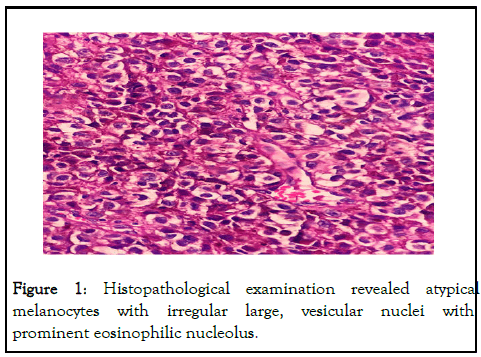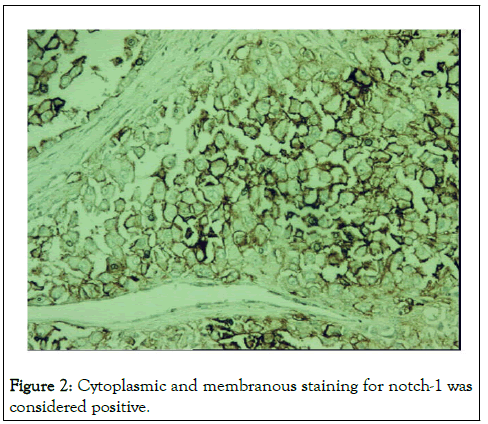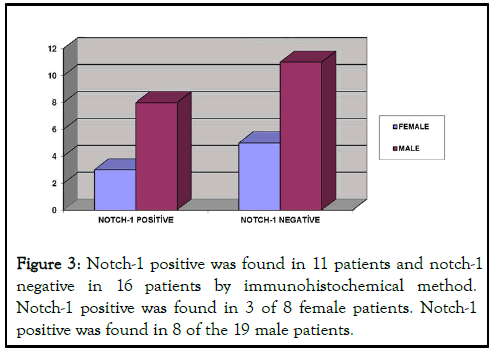Journal of Clinical & Experimental Dermatology Research
Open Access
ISSN: 2155-9554
ISSN: 2155-9554
Research Article - (2024)Volume 15, Issue 6
Background: Currently, several new treatment strategies targeting specific signaling pathways and immunotherapy are being explored for malignant melanoma. We investigated the relationship between notch-1 gene expression by immunohistochemistry in patients with malignant melanoma.
Objective: We investigated the relationship between malignant melanoma and notch-1 in this study.
Methods: In our study, 10 patients with intradermal nevus and 27 patients with malignant melanoma were studied by immunohistochemistry with notch-1.
Results: We found notch-1 expression in 11 of our 27 patients. There was a significant correlation between sentinel lymph node metastasis and notch-1 expression (p<0,05). Our study has shown that the notch signaling pathway is associated with sentinel lymph node metastasis. As a result of our work, notch pathway is involved in malignant melanoma formation and lymph node metastasis. It should be kept in mind that the effect of the notch pathway on malignant melanoma may be beneficial in targeted treatment.
Malignant melanoma; Notch-1; Notch pathway; Immunotherapy
Melanoma is an aggressive skin cancer type with limited treatment options. The incidence of melanoma has increased dramatically in recent years. In these days, 1 in 63 Americans will develop melanoma during their lifetime. Today, melanoma has been accepted as a multi-factorial disease resulting from the interaction between genetic susceptibility and environmental exposure. The most important and potentially interchangeable environmental risk factor for malignant melanoma development is exposure to UV (Ultraviolet) rays due to its genotoxic effects. The most important host risk factors are the number of melanocytic nevi, familiar history and genetic susceptibility. Melanocytic nevi are benign accumulations of melanocytes or nevus cells and melanocytic nevi may be congenital or acquired [1].
The notch signaling network is deregulated in human malignancies, notch family have become attractive targets for selective killing of malignant cells. The notch signaling pathway plays an important role in cell fate decisions during development and also regulates cell-cell interactions involving stem cell behavior, cell proliferation and differentiation.
In recent years, since malignant melanoma patients have not been an effective treatment modality, researchers have begun to examine the carcinogenesis pathways in malignant melanoma in a more detailed way. They also tried to find better treatment methods for patients with targeted treatment through these pathways. We think that the notch pathway is one of the promising pathways for targeted therapy in malignant melanoma patients. So we investigated the relationship between malignant melanoma and notch-1 in this study [2].
Tissue samples
The study has been conducted by the principles of the helsinki declaration and approved by the institutional review board. Thirty-seven patient diagnosed with 2006-2011 in Akdeniz university medical faculty department of pathology were selected for the study. Hematoxylin-Eosin (H and E) stained preparations obtained from formalin-fixed, paraffin-embedded blocks were removed from the archive and re-examined. Optimal blocks for immunohistochemistry were selected [3]. The anamnesis, stage, diagnosis history, treatment follow-up times of the cases were learned from our hospital automation system, patient follow-up files and by themselves and their relatives via telephone (Figure 1).

Figure 1: Histopathological examination revealed atypical melanocytes with irregular large, vesicular nuclei with prominent eosinophilic nucleolus.
Immunohistochemistry
Receipt sections were made using the standard procedure in a Daco automatic staining machine with notch-1 immunohistochemical staining. The following staining protocol was applied for notch-1 immunohistochemical staining. The sections were immersed in paraffin at 55°C overnight. The next day the sections were removed with xylene. The sections were rehydrated in decreasing alcohol series. The sections were washed with distilled water. At 95°C-98°C in a water bath, notch-1 was boiled for 50 min in Ph 7 EDTA buffer solution, allowing the epitope to be released by heat. The sections were allowed to cool at room temperature. The sections were then washed in TRIS buffer solution. Endogenous peroxidase activity was blocked by standing for 15 min in a 3-fold hydrogen peroxide solution. The sections were then washed in tris buffer solution [4].
Nonspecific binding reactions were prevented by dropping the ultra V block for 10 min. Pour the solutions on the slides before washing; a suitable primer antibody at 1/50 dilution was added and antibody incubation was performed at room temperature for 1 hour to allow antibody binding. The sections were then washed in tris buffer solution. Biotin was added dropwise at room temperature for 10 min incubation. The sections were then washed in tris buffer solution. Streptavidin was added dropwise at room temperature for 10 min incubation. The sections were then incubated in tris buffer solution for 20 min. A solution of Diaminobenzidine (DAB) was prepared by adding 1 ml of substrate and 1 drop of the chromogen (1:1). Each section was dripped from 100 microliters of the prepared DAB solution and allowed to stand at room temperature for 7 min. Then the sections taken on foot were washed in tap water. Mayer's hematoxylin was allowed to stand for about 1 minute for contrast staining. The sections were then washed in tap water. The sections passed through the rising alcohol series for 2 minutes each were then placed in 10 minutes of xylolite. Finally, the lamella was covered on the claims [5]. Cytoplasmic and membranous staining for notch-1 was considered positive (Figure 2).

Figure 2: Cytoplasmic and membranous staining for notch-1 was considered positive.
Thirty-seven cases diagnosed between 2006-2011 in Akdeniz university medical faculty pathology department were selected for this study. Of these, 10 are intradermal nevus and 27 are malignant melanoma who underwent sentinel lymph node of these patients, 19 are male and 8 are female. Tumor localization was observed in 15 cases of lower extremity, 5 cases in the back of the trunk, 3 cases in the head and neck region, 2 cases in the lower extremity and 2 cases in the frontal surface of the trunk of our patient with a diagnosis of malignant melanoma. Twenty-six patients had no precursor lesion, only one patient had a dysplastic nevus as a precursor lesion [6]. 14 patients had nodular malign melanoma, 9 patients had acral lentiginous malign melanoma, 3 patients had superficial malignant melanoma and 1 patient had balloon cell malign melanoma. Radial and vertical growth phases were observed in 15 patients and vertical growth phase was seen in 12 patients. In 8 of our patients, less than 50% of the patients had tumor regression, whereas in 19 of our patients there was no tumor regression. Neurotropism was observed in 10 patients and neurotropism was not observed in 17 patients.
The mean age of our 11 patients with notch-1 positive was 60.18 and the mean of tumor thickness was 2.78 cm. Notch-1 expression was not statistically significant with age, tumor size, clark level and breslow thickness (p>0.05). In our 11 patients, sentinel lymph node metastasis occurred in 8 of these patients with the notch-1 positive. Sentinel lymph node metastasis and notch-1 expression were statistically significant (p<0.05) [7].
The aim of the presnt study was to investigate the frequency and clinicopathologic features associated with notch 1 gene expression and their relationships with clinicopathologic characteristics in patients with malignant melanoma. The study demostrated that a significant correlation between sentinel lymph node metastasis and notch-1 expression (p<0,05). Cutaneous malignant melanoma is a very fatal skin cancer and its prevalence in the world is increasing. Most patients have localized disease at the time of the diagnosis and are treated by surgical excision of the primary tumor, but after treatment, many patients develop metastases [8]. Numerous studies have identified solar UV radiation as the predominant environment risk factor for the development of cutaneous melanoma and the number of UV-induced sunburns is a strong predictor of melanoma incidence.
It is well known that notch signaling regulates normal and cancer development in many tissues. We know that notch signaling is necessary for embryonic, postnatal and adult growth and development. In the skin, notch-1 has a role in coordinating differentiation of squamous epithelia and deletion of notch-1 expression in mouse skin resulted in hyper proliferation of the basal epidermal layer, culminating in the development of skin tumors in 95% of mice. Notch inhibitor studies implicate notch signaling as a necessity for melanoma survival. Additional experiments suggest that survival is not the only cellular process influenced by the notch cascade in melanoma cells [9].
The role of notch-1 in primary melanomas has been investigated and it has been shown that the notch signaling pathway is indeed activated in human melanoma and that constitutive activation of the pathway confers metastatic capability to primary melanoma cells in vivo. It is thought that the metastatic potential of notch activation in primary melanoma cells is partly due to changes in the adhesion properties of melanoma cells in the regulation of notch activation (Figure 3) [10].

Figure 3: Notch-1 positive was found in 11 patients and notch-1 negative in 16 patients by immunohistochemical method. Notch-1 positive was found in 3 of 8 female patients. Notch-1 positive was found in 8 of the 19 male patients.
Massi and colleagues immunohistochemically examined notch-1, notch-2, jagged-1, jagged-2 and delta-like-1 in 5 patients with cutaneous common melanocytic nevi, 5 with displaced nevi, 5 with cutaneous in situ melanoma, 5 with malignant melanoma and 5 with subcutaneous melanoma metastasis [11]. In this study, positive staining with notch-1 was observed in primary invasive melanomas, independent of tumor thickness. But there was no difference between the primer and the metastatic melanoma. And they found no staining with notch-1 in cutaneous common melanocytic nevi. Notch receptors have been studied in primary uveal melanoma patients and it has been found that the notch pathway plays a role in the invasion and proliferation of uveal melanoma and inhibition of this pathway can prevent tumor growth and metastasis. In the recent studies, the relationship between the notch pathway and the tumor cells into the capillary-like structures in the melanoma was investigated and found to be related to the notch pathway of vasculogenic mimicry [12].
As a result, in this study, we found that sentinel lymph node metastasis and notch-1 expression were statistically significant. When evaluated together with all these studies, it is clear that the notch pathway is involved in malignant melanoma formation and lymph node metastasis. It should be kept in mind that the effect of the notch pathway on malignant melanoma may be beneficial in targeted treatment. There is a need for more extensive research to clarify the literature on this subject.
No conflict of interest was declared by the authors.
No financial disclosure was declared by the authors.
[Crossref] [Google Scholar] [PubMed]
[Google Scholar] [PubMed]
[Crossref] [Google Scholar] [PubMed]
[Crossref] [Google Scholar] [PubMed]
[Crossref] [Google Scholar] [PubMed]
[Crossref] [Google Scholar] [PubMed]
[Crossref] [Google Scholar] [PubMed]
[Crossref] [Google Scholar] [PubMed]
[Crossref] [Google Scholar] [PubMed]
[Crossref] [Google Scholar] [PubMed]
[Crossref] [Google Scholar] [PubMed]
[Crossref] [Google Scholar] [PubMed]
Citation: Bayramoglu Z, Unal B, Ozkan O, Bassorgun CI (2024) Research of Notch-1 Expression with Immunohistochemical Method in Malignant Melanoma. J Clin Exp Dermatol Res. 15:672.
Received: 24-Feb-2020, Manuscript No. JCEDR-24-3469; Editor assigned: 27-Feb-2020, Pre QC No. JCEDR-24-3469 (PQ); Reviewed: 12-Mar-2020, QC No. JCEDR-24-3469; Revised: 02-Sep-2024, Manuscript No. JCEDR-24-3469 (R); Published: 30-Sep-2024 , DOI: 10.35841/2329-9509.23.15.680
Copyright: © 2024 Bayramoglu Z, et al. This is an open-access article distributed under the terms of the Creative Commons Attribution License, which permits unrestricted use, distribution, and reproduction in any medium, provided the original author and source are credited.